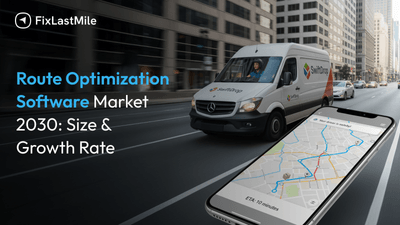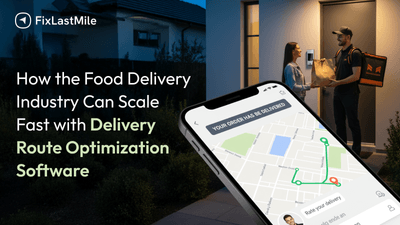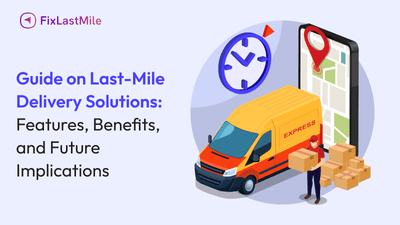Last-mile delivery is often where logistics businesses face their biggest challenges.
These challenges lead to missed deliveries, poor driver-dispatch communication, and frustrated customers. And the major reason behind this failure is often caused by outdated communication methods.
If you are facing these same challenges and looking to improve your operations, real-time communication in logistics is essential.
In this blog, you will learn how real-time communication in logistics can eliminate chaos, boost efficiency, and enhance customer satisfaction.
Furthermore, you will read logistics apps with live driver updates, tools for real-time delivery coordination, and how to choose the best communication platform for last-mile delivery.
By the end of this blog, you'll understand how improving communication can streamline your processes and ensure timely deliveries every time.
The Common Challenges in Last-Mile Delivery
Last-mile delivery is often where things go wrong in the logistics chain.
Businesses face a variety of challenges, and if you're managing logistics, you’ve likely encountered a few of these problems yourself.
Missed Deliveries
These are one of the most frustrating challenges. Whether it's due to miscommunication, incorrect address details, or a last-minute change in the schedule, missed deliveries can quickly spiral into customer dissatisfaction and increased operational costs.
Customers are increasingly impatient and missed deliveries can cost your business their trust.
According to a report by McKinsey, real-time communication can reduce delivery delays by 30%, minimizing these missed deliveries and improving reliability.
Poor Driver-Dispatch Communication
Without clear and instant communication, drivers and dispatchers are left playing catch-up.
This often leads to confusion about schedules, routes, and delivery times. It’s hard to make quick adjustments when you're relying on outdated methods like phone calls or text messages.
Customer Frustration
Today’s customers expect timely deliveries and updates. Without real-time tracking and communication, it’s easy for them to feel left in the dark, which affects your brand reputation.
When communication is unclear or delayed, the result is a negative experience that costs both time and customer loyalty.
These problems can be overwhelming, but the good news is that they’re entirely preventable.
By using real-time communication tools, businesses like yours can drastically reduce delivery failures and improve customer satisfaction. So, what can you do to change this?
The Role of Real-Time Communication in Resolving Last-Mile Chaos
Once you recognize the common challenges, the next question is: how can these be addressed effectively?
The answer lies in real-time communication in logistics.
By ensuring that all parties (dispatchers, drivers, and customers) are on the same page, you can minimize miscommunication and optimize the entire delivery process.
Instant Updates to All Stakeholders
Real-time communication is a game-changer. With logistics apps with live driver updates, dispatchers can monitor the driver’s location in real time, while customers can track their orders.
This means there are no surprises, and everyone is informed at every step of the process.
Whether it’s a rerouted delivery or an unexpected delay, real-time updates ensure that drivers , dispatchers, and customers are always in sync, preventing confusion and frustration.
A recent survey by PwC found that 72% of logistics companies saw a 25% improvement in efficiency after adopting real-time tracking systems, showing how live updates reduce operational delays.
Efficient Coordination and Quick Adjustments
Effective tools for real-time delivery coordination allow for instant communication between drivers and dispatchers.
Gone are the days of relying on phone calls or text messages. By using integrated apps, you can ensure driver-dispatch communication is instant, clear, and accurate.
If there’s an issue such as traffic delays or an address mix-up, it can be addressed immediately which reduces the chances of missed deliveries or delays.
Enhancing the Customer Experience
Finally, the best communication platform for last-mile delivery is one that not only streamlines internal operations but also improves the customer experience.
With real-time tracking, your customers can receive updates directly to their phones. This reduces anxiety and builds trust.
When communication is transparent, customers are more likely to stay loyal which ultimately improves both their experience and your brand’s reputation.
In fact, 89% of consumers say they would be more likely to engage with a business that provides real-time delivery updates (source: Statista).
Implementing Real-Time Communication: Tools and Technology
Now that you understand the importance of real-time communication in logistics, the next step is figuring out how to implement it effectively.
The right tools for real-time delivery coordination can transform how your business handles last-mile delivery.
But what exactly do you need to make this shift? You will explore it below.
Mobile Apps for Drivers: Keeping Everyone Connected
One of the most crucial steps in integrating real-time communication is using logistics apps with live driver updates.
These apps provide drivers with route information, traffic updates, and delivery status changes in real time.
They also allow dispatchers to track the location of every driver, ensuring efficient driver-dispatch communication.
By having this live data at their fingertips, drivers can make quick decisions such as rerouting or adjusting delivery schedules to avoid delays.
Centralized Communication Platforms
Another vital tool is a centralized communication platform. This allows both your drivers and dispatchers to share real-time updates and stay informed about any changes in delivery status.
These platforms offer a one-stop solution for communication that kills the need for phone calls or text messages, which can often be unclear or delayed.
A centralized platform ensures that everyone involved in the delivery process is aligned which improves operational efficiency and reduces human error.
Choosing the Best Communication Platform for Last-Mile Delivery
When selecting the best communication platform for last-mile delivery, look for a solution that seamlessly integrates with your existing systems.
A good platform should support real-time communication, give you control over deliveries, and be easy to use for both drivers and dispatchers.
It should provide live tracking, automated notifications, and a user-friendly interface for all parties involved, from dispatchers to customers.
Real-Time Communication Benefits: Efficiency, Accuracy, and Customer Satisfaction
Now that we've discussed how real-time communication in logistics can resolve some of the common challenges in last-mile delivery, let’s look at the direct benefits it brings to the table.
These are the key improvements businesses can expect by implementing logistics apps with live driver updates and tools for real-time delivery coordination.
Increased Operational Efficiency
One of the most significant advantages of real-time communication is the improvement in operational efficiency.
By using logistics apps with live driver updates, businesses can optimize routes and track delivery progress in real time.
This leads to fewer delays, better planning, and more accurate delivery windows, ultimately reducing operational costs.
When dispatchers can instantly communicate with drivers, they can quickly address issues like traffic delays, rerouting, or rescheduling, ensuring timely deliveries.
Reduced Delivery Failures
Another major benefit is the reduction in delivery failures. By having access to real-time tracking and communication tools, businesses can ensure that every step of the delivery process is monitored.
If there’s a hiccup, be it a delay or a problem with an address—it can be corrected immediately.
This results in fewer missed deliveries, less confusion, and a more reliable system.
Enhanced Customer Satisfaction
Finally, the impact on customer satisfaction cannot be overstated. In today’s world, customers expect real-time tracking and timely updates about their deliveries.
By providing this level of visibility and transparency, you’re building trust with your customers.
When customers know exactly when to expect their deliveries and receive prompt updates if anything changes, it improves their experience and encourages repeat business.
Conclusion
In conclusion, real-time communication in logistics is essential for improving last-mile delivery efficiency.
By using logistics apps with live driver updates and tools for real-time delivery coordination, you can reduce missed deliveries, improve driver-dispatch communication, and enhance customer satisfaction.
The best communication platform for last-mile delivery ensures seamless operations and keeps all parties informed.
Adopting these tools will streamline your processes, minimize failures, and ultimately create a more reliable and customer-friendly delivery experience.
It’s time to invest in real-time communication to ensure timely and successful deliveries every time.
Prevent Last-Mile Delivery Failures with Real-Time Communication
FAQ'
Real-time communication in logistics ensures instant updates and coordination between drivers, dispatchers, and customers. It uses logistics apps with live driver updates to improve delivery efficiency and accuracy.
Logistics apps with live driver updates help optimize routes, track deliveries in real time, and keep drivers and dispatchers connected. This reduces delays and enhances delivery accuracy.
Tools for real-time delivery coordination, like logistics apps with live driver updates, improve driver-dispatch communication by providing instant updates and real-time tracking, ensuring smoother operations.
Real-time communication keeps customers informed with accurate delivery updates. This reduces frustration, builds trust, and enhances the overall delivery experience, improving customer satisfaction.
A real-time communication system helps reduce missed deliveries, improves driver-dispatch communication, and ensures timely updates for customers, leading to more efficient and reliable last-mile delivery.




